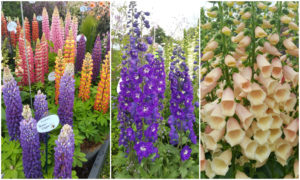This Week’s Guest Blogger is Dr Elizabeth Dauncey, freelance poisonous and medicinal plant scientist
 Poisonous plants can be an emotive subject. Every year the press covers stories about deadly plants encountered in the countryside or sprouting unbidden in someone’s garden. Often, the general conclusion is that this shouldn’t be allowed. The British flora includes some very poisonous plants, and a number of our valued and beautiful garden plants are also toxic. But accidents can be avoided if reasonable precautions are taken. Eradication is not the answer – education is.
Poisonous plants can be an emotive subject. Every year the press covers stories about deadly plants encountered in the countryside or sprouting unbidden in someone’s garden. Often, the general conclusion is that this shouldn’t be allowed. The British flora includes some very poisonous plants, and a number of our valued and beautiful garden plants are also toxic. But accidents can be avoided if reasonable precautions are taken. Eradication is not the answer – education is.
30 years ago, as I was approaching the end of my PhD (a taxonomic revision of a group of Dendrobium orchids from South East Asia) I got a job as a botanist working for the National Poisons Information Service and based at the Royal Botanic Gardens, Kew. It opened my eyes to a fascinating area of plant science, and ever since then I’ve enjoyed learning about and researching poisonous plants, sharing this knowledge and creating various resources for the public, medical professionals, and horticulturists.
A recent piece of work that I did for the UK’s Horticultural Trades Association enables growers and the public to be aware of which plants on sale in the UK may be poisonous to people or pets. Some growers and suppliers will have the resources to label these plants with the recommended warning, but this is voluntary. But never fear as you can download a copy of the HTA’s Guide to Potentially Harmful Plants, 3rd Edition (2022) for free:
https://hta.org.uk/potentiallyharmfulplants
Many gardeners will be unconcerned about the toxicity of the plants that they grow. After all, they probably aren’t planning to eat their delphiniums. For others, such as those with small children or curious pets, knowing which plants should be treated with caution could prevent a trip to A&E or the vet. And even experienced gardeners may be interested in which plants might be responsible for the mysterious rash that they sometimes get after gardening.

The plants in the HTA Guide can be grown safely provided a few precautions are taken, and those precautions will vary depending on who is using the garden. A few basics are:
- don’t eat any plant unless you are certain that it, or the part you want to eat, are edible. It sounds obvious but you’d be surprised how many people consider the toxicity only after they or their child have eaten something.
- avoid growing poisonous plants amongst those that are edible, aromatic or tactile.
- move poisonous plants to the back of the border, or contain them with a physical barrier, if young children or pets will use the garden unattended. The HTA Guide also covers house plants and it’s advisable to grow these out of reach of curious hands and mouths.
- berries are tempting and these can be removed, if necessary, by pruning after flowering.
- wear gloves and cover skin if handling or working near plants that are harmful to the skin or eyes, such as Euphorbia. These plants don’t mix well with footballs.
- wash your hands after gardening (and before using the toilet!).
So, with your hazard assessment completed, please continue to enjoy growing these beautiful but potentially harmful plants. Where would our cottage gardens be without foxgloves, lupins, or delphiniums, and what can be more lovely in early summer than a house draped in wisteria?
You can follow Liz on Twitter: @liz_dauncey
If you want to learn more about the World’s most poisonous plants, you may be interested in:
Plants that Kill, by Elizabeth Dauncey and Sonny Larsson; Kew Publishing and Princeton University Press, 2018.
https://shop.kew.org/plants-that-kill-a-natural-history-of-the-world-s-most-poisonous-plants
